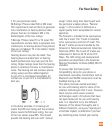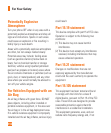
112
For Your Safety
Commissions (FCC) adopted RF exposure
guidelines with safety levels for handheld
wireless phones. Those guidelines are
consistent with the safety standards previously
set by both U.S. and international standards
bodies:
ANSI C95.1 (1992) *
NCRP Report 86 (1986)
ICNIRP (1996)
* American National Standards Institute;
National Council on Radiation Protection and
Measurements; International Commission on
Non-Ionizing Radiation Protection
Those standards were based on
comprehensive and periodic evaluations of
the relevant scientific literature. For example,
over 120 scientists, engineers, and physicians
from universities, government health agencies,
and industry reviewed the available body of
research to develop the ANSI Standard (C95.1).
The design of your phone complies with the
FCC guidelines (and those standards).
Antenna Care
Use only the supplied or an approved
replacement antenna. Unauthorized antennas,
modifications, or attachments could damage
the phone and may violate FCC regulations.
Tips on Efficient Operation
For your phone to operate most efficiently:
Don’t touch the antenna unnecessarily when
the phone is in use. Contact with the antenna
affects call quality and may cause the phone
to operate at a higher power level than
otherwise needed.
Electronic Devices
Most modern electronic equipment is shielded
from RF signals. However, certain electronic
equipment may not be shielded against the RF
signals from your wireless phone.
Pacemakers
The Health Industry Manufacturers Association
recommends that a minimum separation
of six (6) inches be maintained between a
handheld wireless phone and a pacemaker
to avoid potential interference with the
pacemaker. These recommendations are
consistent with the independent research by
and recommendations of Wireless Technology
Research. Persons with pacemakers:
Should ALWAYS keep the phone more than


















